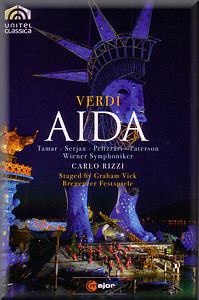 |
 |
|


alternatively
MDT
AmazonUK
AmazonUS
|
Giuseppe VERDI
(1813 – 1901)
Aida (1871)
 Kevin Short (bass) – Il Re; Iano Tamar (soprano) – Amneris; Tatiana
Serjan (soprano) – Aida; Rubens Pelizzari (tenor) – Radamès; Tigran
Martirossian (bass) – Ramfis; Iain Paterson (baritone) – Amonasro;
Ronald Samm (tenor) – Un messaggero; Elisabetta Martorana (soprano)
– Una sacerdotessa
Kevin Short (bass) – Il Re; Iano Tamar (soprano) – Amneris; Tatiana
Serjan (soprano) – Aida; Rubens Pelizzari (tenor) – Radamès; Tigran
Martirossian (bass) – Ramfis; Iain Paterson (baritone) – Amonasro;
Ronald Samm (tenor) – Un messaggero; Elisabetta Martorana (soprano)
– Una sacerdotessa
Camerata Silesia, Polish Radio Choir Krakow, Bregenzer Festspielchor
Wiener Symphoniker/Carlo Rizzi
Directed by Graham Vick, Set and Costume Design: Paul Brown, Lighting
Design: Wolfgang Göbbel, Choreography: Ron Howell
Video Director: Felix Breisach
rec. live, Bregenzer Festspiele, Seebühne, 17, 22, 24 July 2009
Filmed in High Definition. Mastered from an HD source.
Picture format: NTSC 16:9; Sound formats: PCM 2.0 DD 5.1
 UNITEL CLASSICA 702308
UNITEL CLASSICA 702308  [135:00] [135:00]
|
|
|
At Bregenz one can expect spectacular productions – or at least
conspicuous ones. I am talking about Opera on Lake Bodensee
which takes place in July and August each year. It’s part of
the Bregenz festival which provides a lavish offer of opera,
theatre and concerts. The outdoor stage surrounded by water
invites gigantic sets and the long distance to the grandstand
on the shore requires amplifying equipment. I have seen some
productions on DVD and also some stills. They are generally
provocative, putting the characters in settings as far away
from the original as can be imagined. Il trovatore a
few years ago took place in an industrial landscape, possibly
on an oil platform. This Aida goes even further. The
water here isn’t ocean deep but allows the actors to wade, to
swim, to fall in or splash, even to be drowned. During the prelude
two lifeless bodies hanging on a wire attached to an enormous
building crane, are slowly transported before the eyes of horrified
onlookers until they are lowered down into a barge off the stage.
In Trovatore fire was central to the proceedings; in
Aida water has the same importance, the Nile being the
life-blood of the Egyptians. There is a water ballet in the
triumphal scene. The tomb episode takes place on a ship drifting
among the waves. During the final duet the ship rises from the
water and sails into the sky, leaving Amneris alone at the waters’
edge. A real amphibious opera.
Dominating the stage picture are two monstrously big, blue feet.
Why are they there? Whatever the reason they appear to function
as the firm foundation around which the action rotates, whether
it be Aida, the slave girl, scrubbing the floor, Amneris in
black dotted evening gown airing her human ‘dogs’ or high priests
and soldiers invading the stage. There are activities aplenty
with numerous extras just being there, costumes are a mix of
modern and ancient. All this business tends to suffocate the
central conflicts and it is typical of the performance that
it is in the Nile scene – act III – that the action grabs the
viewer by the throat; this is the first scene with no external
distractions. In a way this is dramaturgically sensitive, since
the first two acts primarily deal with festivities, while the
core of the drama is the triangle Aida – Amonasro – Radames.
This is an oversimplification of the plot. There are many strands
in the libretto and Amneris – though basically an evil character
but one who loves – is the hub around which everything rotates.
In this performance it also becomes obvious why Verdi initially
contemplated naming the opera Amneris.
Iano Tamar, the Georgian soprano who was also a great Leonora
in Il Trovatore, is the star; her somewhat darkish
timbre contrasting well with Tatiana Serjan’s girlish Aida.
Tamar has authority and a thrilling lirico-spinto voice. In
the first scene in act IV she is truly great. Serjan at first
seems too lyrical for Aida, having a fluttery soubrette voice
but it sits well with her youthful looks. Her Ritorna vincitor
is however sung with intensity and in the third and fourth acts
she grows in stature, no doubt inspired by Scottish baritone
Iain Paterson’s powerful Amonasro. He is an unusually dangerous
Ethiopian king. Rubens Pelizzari is a rather pale Radamès in
the first two acts but like his Aida he grows and in the Nile
duet he finds a glow that has eluded him before. O terra
addio, though sung in a strange setting, is delivered with
lyrical beauty and warmth by both artists. Tigran Martirossian
is an acceptable Ramfis but Kevin Short’s King is terribly wobbly.
As so often with these Bregenz productions one ends up in two
minds. They’re innovative for sure, and this Aida is
no exception. One can marvel at ideas that suddenly illuminate
the proceedings but just as often one thinks: ‘What’s the point
of this?’ Carlo Rizzi keeps things together and draws splendid
playing from the Wiener Symphoniker. The choral forces have
no easy task to walk all those stairs and balance on wet slippery
stones while keeping an eye on the conductor but they manage
it well. Sound and pictures are good. Readers have to decide
from my descriptions whether this is a DVD worth spending money
on, but Iano Tamar’s glorious Amneris should definitely be seen
and heard.
Göran Forsling
|
|

